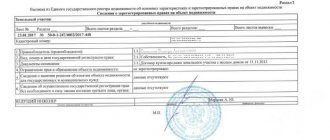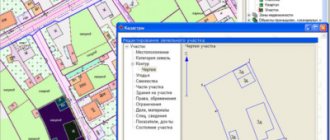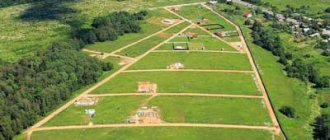When analyzing legal practice, it becomes clear that usually part of a real estate property cannot be considered a full-fledged object of property relations. However, the issue regarding part of the land plot is controversial. At present, agreements have already begun to be concluded in which parts of land plots are used as full-fledged objects of law.
Concept and object
Part of a land plot is not a piece of property. If a person owns the entire plot, then he cannot be the owner of its part. Otherwise, the conclusion is that one title is awarded to a person twice. This fact is confirmed by the practice in which it is considered impossible to be the owner of only part of a plot of land if cadastral registration has been carried out in relation to the entire plot. Part of the land plot in the cadastre is displayed separately based on the owner’s desire to encumber this territory with a lease, mortgage or easement.
Article 6 of the Land Code of the Russian Federation states that the objects of the relevant relations are parts of the land plot. The law does not directly call them objects of rights. At the same time, if part of the land plot is the objects of relevant relations, then it would be logical to recognize them as objects of civil rights.
Rental registration procedure
Regardless of the method of individualization, the lease of a part of the land plot is formalized through the conclusion of an agreement. It is a written document on the basis of which the lessor must provide the tenant with his land (or part of it) free of charge for temporary possession and use (or temporary use).
The agreement must contain the following essential provisions:
- Subject - a detailed description of part of the site with data on its area, location, cadastral number (if available).
- Price - the amount of rent for the use of real estate, as well as the procedure and schedule for making payments.
- Validity period - the period for which the agreement is concluded (otherwise the transaction will be considered unlimited).
- Information about the parties, their rights, obligations, responsibilities.
The procedure for concluding a lease agreement depends on its term:
- A short-term document (up to a year) is drawn up in simple written form and signed by each party.
- Long-term (more than a year) requires subsequent registration with Rosreestr.
In accordance with paragraph 3 of Art. 44 Federal Law “On State Registration of Real Estate”, registration of the agreement itself is carried out in relation to the part of the land plot that:
- already registered in the Unified State Register of Real Estate (USRN);
- not yet taken into account. In this situation, it will be registered simultaneously with the contract.
It is important to emphasize that the division of a land plot under lease is difficult until its end. The ownership of the plot is encumbered for the duration of the transaction.
To register the agreement you must provide:
- an application from the owner or tenant (if there is no information about the share in the Unified State Register of Real Estate, an additional application for its registration is not required);
- applicant's passport;
- technical (land survey) passport;
- lease agreement with all attachments;
- a receipt for payment of the state duty (2000 rubles for an individual).
The application and attachments to it can be submitted:
- in person at Rosreestr;
- on the Rosreestr website;
- by sending documents by Russian Post;
- through a multifunctional center;
After 7 days, the lease of a share of the land plot will be registered. The registrar will issue an agreement with a note to this effect.
When part of the land plot is the object of law
From the provisions of the current law, we can conclude that the consideration of part of the allotment as an object of civil rights is directly related to such concepts as lease, pledge and easement.
At the same time, a pattern can be traced in the norms of civil law, which lies in the fact that it is possible to define parts of land plots as objects of property rights. Relevant provisions can be found in various laws other than the Civil Code.
Considering parts of the boundaries of a land plot and itself as an object of civil law can be considered as a forced concession on the part of the legislator, a kind of departure from theory (legal) to practice (economic). Part of the allotment is considered indivisible without special procedures provided for by law (cadastral registration). Thus, after the appropriate event, it actually becomes divisible.
In the general theory of law, the objects of legal relations are those material and intangible benefits regarding which relations develop between various subjects.
In accordance with Art. 6 of the Land Code of the Russian Federation (hereinafter referred to as the Land Code of the Russian Federation) objects of land relations: 1. Land as a natural object and natural resource. The allocation of land as a natural object is associated with relations to protect land and monitor compliance with requirements for the protection and rational use of land. 2. Land plots. As an object of land relations, it is a part of the earth’s surface (including the soil layer), the boundaries of which are described and certified in the prescribed manner. The legislation sets several essential requirements for registration of a land plot. A land plot as an object of relations must be individually defined - it must have boundaries defined in accordance with the law and enshrined in legal and other documents. The location, area, intended purpose, and permitted use must also be known about the land plot. As an object of ownership and other rights provided for by the Land Code of the Russian Federation, land is an immovable thing that represents a part of the earth's surface and has characteristics that make it possible to define it as an individually defined thing. Actions to form land plots form the basis of land management activities, regulated by the norms of both the Land Code of the Russian Federation and the Federal Law “On Land Management”. In cases and in the manner established by the Federal Law, artificial land plots may be created. A land plot can be: - divisible - which can be divided into parts, each of which, after division, forms an independent land plot, the permitted use of which can be carried out without transferring it to land of a different category, except for cases established by the Federal Law. - indivisible - in accordance with Art. 133 of the Civil Code of the Russian Federation, a thing is recognized as indivisible, the division of which in kind is impossible without changing its purpose. According to Art. 11.9. Land Code of the Russian Federation, requirements for formed and changed land plots: 1. The maximum (maximum and minimum) sizes of land plots in respect of which, in accordance with the legislation on urban planning activities, urban planning regulations are established, are determined by such urban planning regulations. 2. The maximum (maximum and minimum) sizes of land plots to which town planning regulations do not apply or in respect of which town planning regulations are not established are determined in accordance with this Code and other federal laws. 3. The boundaries of land plots should not cross the boundaries of municipalities and (or) the boundaries of populated areas. 4. The formation of land plots is not allowed if their formation leads to the impossibility of the permitted use of real estate located on such land plots. 5. The division, redistribution or allotment of land plots is not allowed if the encumbrances (restrictions) retained in relation to the land plots being formed do not allow the use of these land plots in accordance with the permitted use. 6. The formation of land plots should not lead to wedging, interspersing, broken boundaries, interstriations, the impossibility of placing real estate objects and other shortcomings that impede the rational use and protection of land, and also violate the requirements established by this Code and other federal laws. 7. The formation of a land plot, the boundaries of which cross the boundaries of territorial zones, forest districts, forest parks, is not allowed, with the exception of a land plot formed for carrying out work on geological exploration of subsoil, development of mineral deposits, placement of linear objects, hydraulic structures, as well as reservoirs, etc. artificial water bodies. 3. Parts of land plots. 4. Land shares in a land plot that is in common shared ownership are an independent object of land rights; at the same time they do not stand out on the ground. The inclusion of land and land plots in civil legal circulation does not detract from their significance as a natural object, a natural resource.
Features of the procedure for obtaining a cadastral passport
When work is carried out on the cadastre, the specialist will not only have to keep records and calculate the area of part of the land plot, but also take into account the legal consequences. It is important to know what will happen in the future with the part of the plot of land for which cadastral registration is carried out. For example, the Law “On Cadastral Activities” No. 221-FZ, in particular, paragraph 4 of Article 24, states that the data entered into the cadastre during registration is temporary. They lose their corresponding character from the moment of state registration of the property. Or when a formed object arises. If, after a year from the date of registration, state registration of the lease is not carried out, then this information is canceled and is not included in the cadastre of real estate.
If the applicant has submitted to the cadastral authority a boundary plan that contains data on the land plot and its part being created at the same time, then after canceling the data on the corresponding part, only the decision made will be sent to the applicant. The boundary plan is not sent to him, since it contains sections in which the temporary status of part of the land plot has not expired or has been changed to the “accounted for” temporary status that the land has (land plot, part of the land plot).
That is why the engineer must understand before starting work what the customer is going to do with part of the land in the future. Otherwise, a situation may occur in which, after the expiration of the established period, the cadastral data will be canceled and the corresponding work will need to be carried out again.
Legislative framework for renting part of a plot
The turnover of allotments is regulated by the norms of the Land Code of the Russian Federation dated October 25, 2001 N 136-FZ (hereinafter referred to as the Land Code of the Russian Federation). They establish not only the concept of a land plot, but also the rules of ownership, use and disposal of it.
The Land Code of the Russian Federation establishes that the owner can dispose of his land in any legal way. Including renting out in whole or in part.
In turn, the provisions of Art. 260 part one of the Civil Code of the Russian Federation (hereinafter referred to as the Civil Code of the Russian Federation) does not contain any restrictions on the transfer of part of the allotment for temporary paid use. The only condition is its clear definition in the text of the contract.
Thus, the question of whether it is possible to rent part of a land plot should be answered in the affirmative.
Most often, such transactions are concluded between neighbors. They are also common among owners of large “idle” lands.
Information in the cadastre
Clause 1 of Article 5 of Law No. 221-FZ, mentioned above, states that real estate objects included in this cadastre are assigned a unique registration number on the territory of Russia. The cadastre contains information about a specific property, in particular:
- type (land plot or part thereof, building, premises, etc.);
- cadastral number indicating the date of entry into the State Property Committee;
- description of the boundaries of the object (if it is a land plot or part of it);
- square.
If part of the property is subject to an encumbrance that does not apply to the entire property, this information is also indicated in the cadastre.
Persons who have the right to apply to the cadastre to register part of a land plot are the owners of the property or those in whose favor the corresponding encumbrances are established.
Changes in the law on accelerated seizure of land plots
If the court determines the need for cadastral work, then both it and the specialist’s work are paid in accordance with the standards corresponding to the law on the registry.
When allocating or dividing land that was in co-ownership, everyone has the right to terminate co-ownership and demand their share.
Another distinctive feature is the presence of an approved layout of land plots on the cadastral plan (and an order from the Administration on the allocation of land plots) or a land surveying project in the appendix to the land survey plan. In other cases, the main documents are the title to the land plot and the cadastral extract.
When is a cadastral passport required?
In paragraph 2 of Article 26 of the Law “On State registration of rights to real estate and transactions with it" No. 122-FZ states that if a plot or part of it is leased, then a cadastral passport of the plot must be attached to the lease agreement, which indicates the part to be leased. Based on this provision, we can assume that part of the plot can still be leased without this document. One way or another, a lease agreement for a part of a land plot must be registered if it is concluded for a period of at least one year.
Approximately the same content can be found in paragraph 2 of Article 27 of the same law. It states that if the easement includes part of a plot or other object, then the necessary documents indicating the area of the easement should be accompanied by a cadastral document with a note on the scope of the easement or an extract about this property (in which the relevant information is indicated ). Even if the scope of the easement is associated with a small area compared to the entire plot of land, it may be impossible to use this part of the plot without providing the necessary access.
Preliminary acquisition of rights to a land share
According to the requirements of Part 3 of Article 9 of the Law of July 24, 2002 under number 101-FZ, agricultural land can be leased for a period of 3-49 years.
You can rent pastures with hayfields for no more than 3 years.
The area of land shares is not limited. In this regard, plots of various sizes can be rented.
Typically, several citizens have rights to a land share. In order for one of them to be able to freely rent or otherwise dispose of part of the site, he will need to allocate his share. A citizen will need to draw up a document that will confirm that the allocated land plot does not belong to common ownership. Only after this will he be able to enter into a lease agreement for the share with another person.
The following actions are required from a citizen who decides to allocate a land share:
- Engage a cadastral engineer to draw up a land surveying project.
- Within 30 days, inform other shareholders in writing of your intention to allocate a share.
- Wait for the results of the meeting of shareholders. If the decision is positive, the citizen receives a protocol of consent. The document confirms that other shareholders have no objections regarding the alienation of the share.
- Land management authorities check information both about the citizen himself and about the land allocated to him. The result of the inspection is the formation of a cadastral plan. The share is assigned a number.
To allocate a share, a citizen must submit an application to the land issues committee of his municipal district. Additionally, he will need to attach his passport and consent from other shareholders. A cadastral passport is also attached to the documentation.
If an easement is issued
Article 274 of the Civil Code of the Russian Federation states that easements can be established for the laying and maintenance of power lines, communication lines and pipelines. Part of the land plot (this is where communications are located) always occupies a smaller area compared to that required for installation and maintenance. Therefore, an easement may also provide for a short-term right to use the entire plot or a significant part of it.
Individualization of the site
Most likely, there is no problem in individualizing part of the plot, since the law establishes the possibility of carrying out its cadastral registration. But the problem may be that the usual result of imposing a property penalty is the termination of obligations to the bank (in full or in a certain part), as well as the transfer of property to a third party.
At the same time, the law does not provide for transactions in which ownership of part of a land plot can be registered. Thus, an allotment of land cannot be recognized as a full-fledged object of turnover in civil legislation. From an economic point of view, the pledge would be possible if forced division of the plot was also possible. But at the same time, it is not clear what the collateral object of a part of the allotment could be, if it is considered from the position of jurisprudence.
The fact that part of the land plot is subject to registration is stated in the law “On State. cadastre of real estate objects" No. 221-FZ. In particular, it contains the following provisions:
- when describing the documents required for cadastral registration;
- when establishing accounting features of individual real estate objects and their parts;
- in standards and transfer of the results of work on drawing up a cadastral passport and boundary plan.
How to apply correctly in 2021
First, study the requirements for the site before dividing it.
I published 2 instructions because... Much depends on the number of owners. The instructions are suitable for different types of plots - individual housing construction, private household plots, SNT, etc.
Option No. 1 - when the site is owned by several owners
How to divide a plot if it is owned by several owners - the instructions are suitable for both common shared ownership and joint ownership. The design was laid out in 4 stages.
Option No. 2 - when there is one owner
How to divide a plot if it is owned by one owner. In this case, it is easier to divide the area; the instructions on the link are only 3 steps.
Other articles
How to register ownership of land plots - instructions, laws, cost. How to transfer a land plot: from private subsidiary plots to individual housing construction; with individual housing construction in private household plots; from individual housing construction to “commercial real estate”
Arbitrage practice
Judicial practice, in addition to parts of land plots that have undergone cadastral registration, recognizes that it is not necessary to assign a cadastral number to them in order to legally lease out part of a residential building, a land plot, or rather, part of it. It does not matter whether the contract is concluded for a period of less than a year or is indefinite. The main thing is that it can be individualized by area and location coordinates. Many lawyers believe that registering part of the plot for the purpose of sublease is also optional.
It should be borne in mind that a clear position in judicial practice on this issue has not yet emerged. There are examples in which the consideration of parts of plots as objects of corresponding rights was considered possible only when registering them in cadastral register.
Peculiarities of registration of renting part of an allotment
Since the legislator has not established any restrictions or specifics, the transaction for the use of a share of the object can be formalized after its individualization. This means that it is necessary to make a legal formation of a part of the land plot for lease, which will allow one to reliably understand and describe its boundaries.
This process can be expressed:
- in official land surveying with the application of its results to the technical plan;
- in simple documentary recording - when the description is kept only on paper (in the form of text in the contract and graphic designation on the plan).
If the lease agreement is concluded for a long period, the formed part must be registered in the cadastral register. This involves mandatory land surveying and drawing up a technical plan. This requirement is established by the provisions of Federal Law dated July 13, 2015 N 218-FZ “On State Registration of Real Estate”.
Determining the share of a plot using land surveying
If the lease of part of the land plot is planned as a long-term transaction, it is necessary to determine the share officially. This happens according to the following algorithm:
- Land surveying is carried out, which is the actual delimitation of the allotment at the request or with the permission of the owner. Land surveying is carried out by a cadastral engineer. Based on the results of work on the ground, the specialist will be able to draw up a drawing and create a technical (land survey) plan for part of the site.
- The determination of the share is consistent with the fire, environmental, and sanitary services.
- The boundary plan becomes the basis for assigning part of the plot its own cadastral number.
Cadastral registration is carried out simultaneously with the registration of an agreement to lease a part of the land plot.
Organization of rent without land surveying and cadastral registration
Land owners want to save on the procedure for surveying part of the property by completely abandoning it. However, such tactics are quite risky for both the landlord and the tenant.
For several reasons:
- When carrying out land surveying, the cadastral engineer not only draws up a plan, but also checks the possibility of division.
- When concluding a lease agreement for a long term (more than 1 year), the document will be subject to registration by Rosreestr. Therefore, cadastral registration of part of the land plot is necessary.
- By not insisting on formal identification, the future short-term tenant risks facing fraud. This is dangerous if the landlord's identity and ownership are not properly verified. Particular attention should be paid to the existence of co-owners.
If the period of temporary use does not exceed a year, renting a part of the land plot without land surveying, although reckless, is acceptable. In this case, it is necessary to clearly describe the boundaries of the share in the text of the agreement, as well as display them on a plan that will become an annex to the agreement.





